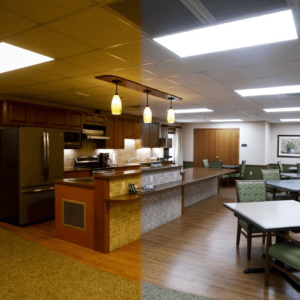Today, In 7 Minutes or Less, You’ll Learn:
- How natural light regulates your sleep, mood, and energy levels.
- Why artificial lighting might be draining your body and brain.
- Simple ways to reset your circadian rhythm and improve well-being.
Why Your Energy Feels Off—And What Light Has to Do With It
You wake up groggy, already dreading the day ahead. The curtains are still drawn, your phone screen is the first thing you see, and the soft glow of your bedside lamp barely shakes the fog in your brain. You pour a coffee, hoping it will do the trick, but by mid-morning, you’re still sluggish, unfocused, and drained. By the time evening rolls around, you’re wired from screen exposure and struggling to switch off.
Sound familiar? It’s not just your sleep schedule that’s out of sync—it’s your light exposure.
For thousands of years, human bodies have been wired to follow the sun. Our ancestors rose with bright, blue morning light that told their brains, “Time to wake up!” and wound down with soft, golden evening light that whispered, “Slow down. Sleep is coming.” But modern life? It’s completely reversed that natural rhythm.
Now, we spend 90% of our lives indoors, constantly exposed to artificial lighting that confuses our biology. Because of this, too little sunlight during the day leaves us tired and unfocused, while excessive blue light at night wrecks our sleep and stress levels. Yet, we rarely stop to ask: What if the way we light our spaces is ruining our health?
If you’ve been feeling chronically tired, anxious, or mentally foggy, the answer may not be another supplement or lifestyle hack—it may be as simple as recalibrating the light in your life.
The Science of Light: Why Your Body Craves the Sun
Light isn’t just about visibility—it’s about biology. Your body has an internal clock, called the circadian rhythm, which controls when you wake up, when you feel energized, and when you get sleepy. And what sets this clock? Light exposure.
Morning sunlight triggers cortisol and serotonin production, making you feel alert and focused. Later in the evening, fading light increases melatonin, helping your body prepare for deep, restorative sleep.
Here’s where things go wrong: Most of us barely get real sunlight during the day, and we drown in artificial light at night. As a result, you might experience:
- Disrupted sleep cycles that leave you exhausted.
- Brain fog and lack of focus during the day.
- Increased stress and anxiety due to excess blue light exposure.
- Weakened immune function because of poor circadian health.
Your body simply wasn’t designed for constant artificial lighting and screen exposure—it needs natural light cues to function optimally.
How Natural Light Affects Your Mood, Sleep, and Energy
Ever noticed how spending a day outside makes you feel refreshed and energized? That’s because natural light isn’t just about seeing clearly—it actively regulates your hormones, brain function, and mood.

- For example, sunlight triggers vitamin D production, which supports immune function and reduces inflammation.
- In addition, natural light exposure boosts serotonin, the “happiness” hormone that regulates mood and focus.
- Most importantly, bright daylight keeps your body clock in sync, helping you feel awake during the day and sleepy at night.
On the flip side, replacing natural light with poor indoor lighting throws off your body’s rhythms. Because of this, you may feel sluggish all day and restless at night—and no amount of coffee or sleep supplements can fully fix it.
Artificial Light: The Hidden Disruptor of Your Well-Being
Modern homes and offices are flooded with artificial lighting, and while it helps us work late and binge-watch Netflix, it’s also silently wrecking our health.
🔹 Exposure to blue light from screens and LED bulbs suppresses melatonin, making restful sleep more difficult.
🔹 Fluorescent lighting overstimulates stress hormones, often leading to headaches and eye strain.
🔹 A lack of full-spectrum daylight leaves you sluggish and mentally foggy.
Over time, too much artificial light and too little natural light can contribute to:
- Insomnia and poor-quality sleep.
- Increased stress, irritability, and anxiety.
- Chronic fatigue and energy crashes.
- Reduced cognitive function and memory issues.
The solution isn’t to avoid artificial light completely—it’s about finding the right balance.
Rebalancing Light in Your Home & Daily Life
We can’t always control how much time we spend outside, but we can control how we light our spaces. Here’s how to reset your circadian rhythm and use light as a wellness tool:
1. Get More Natural Light (Especially in the Morning)
Expose yourself to real daylight as soon as possible after waking up.
Try this:
- Open your curtains first thing in the morning.
- Drink your coffee outside or near a bright window.
- Take a 10-minute morning walk (even if it’s cloudy).
2. Upgrade Your Indoor Lighting
Since we spend most of our time inside, indoor lighting should mimic natural light:
- Switch to full-spectrum bulbs that adjust from cool morning light to warm evening hues.
- Use wake-up lights that gradually brighten like a sunrise.
- Ditch bright white LEDs at night and use warm, dim lighting instead.

3. Reduce Blue Light in the Evening
Too much blue light blocks melatonin, so limit exposure at night:
- Enable Night Mode on your phone and computer.
- Use amber-toned lighting after sunset instead of bright LEDs.
- Try blue-light-blocking glasses if you work late.
4. Use Feng Shui to Optimize Light Flow
Lighting isn’t just about brightness—it’s about energy flow. In Feng Shui, well-lit spaces encourage vitality, harmony, and positive Qi (life force energy):
- Keep windows unobstructed to let in natural light.
- Use mirrors strategically to reflect light into darker areas.
- Choose warm lighting for relaxation spaces like bedrooms and cool lighting for productivity zones.
Final Thoughts: Why Light is the Ultimate Wellness Hack
Light is one of the most powerful, yet overlooked factors in your well-being. It shapes your sleep, mood, and energy levels—and with a few small adjustments, you can reset your body’s rhythm and feel better every day.
✔ Start your day with natural light to boost energy and mental clarity.
✔ Upgrade your indoor lighting to mirror the sun’s natural cycle.
✔ Cut down on blue light exposure in the evening to improve sleep and relaxation.
✔ Incorporate Feng Shui principles to optimize light flow and create a balanced, harmonious space.
By making these simple shifts, you’ll start to feel more awake in the morning, focused during the day, and naturally sleepy at night—without needing to rely on caffeine or sleep aids.
Found this blog useful?
⚡️ Don’t keep it to yourself—send this to a friend who’d love it too!
⚡️ Come tell me your biggest takeaway on Instagram @TheLowToxShop—I’d love to hear from you!
Citations & Research
Open the folder for Sources & Further Reading.
Blume, C., & Münch, M. (2025). Effects of light on biological functions and human sleep. Handbook of Clinical Neurology. Elsevier. https://www.sciencedirect.com/science/article/pii/B9780323909181000083
Barroggi Constantino, D., Lederle, K. A., & Middleton, B. (2025). The bright and dark side of blue-enriched light on sleep and activity in older adults. GeroScience. Springer. https://link.springer.com/article/10.1007/s11357-025-01506-y
Grzelak, A. (2024). Managing blue light exposure: Impacts on sleep quality and circadian health. Quality in Sport. https://apcz.umk.pl/QS/article/view/56741
Gubin, D. G., Borisenkov, M. F., & Kolomeichuk, S. N. (2024). Evaluating circadian light hygiene: Methodology and health implications. Open Medicine Journal. ResearchGate. https://www.researchgate.net/profile/Mikhail-Borisenkov/publication/387968034_Evaluating_circadian_light_hygiene_Methodology_and_health_implications/links/678662d1f8b7bf1abcb90df6/Evaluating-circadian-light-hygiene-Methodology-and-health-implications.pdf
Husnain, M., Shahid, M., & Sajjad, M. (2025). The effects of social media on sleep quality and eye health: A comprehensive review. Journal of Social Education, Health, and Psychology. http://journal-of-social-education.org/index.php/Jorunal/article/view/103
Li, Q., Xu, Y., Lu, X., Shen, Y., Wan, Y., Su, P., & Tao, F. (2025). Impact of bedroom light exposure on glucose metabolic markers and circadian-dependent meal timing: A population-based cross-sectional study. Ecotoxicology and Environmental Safety. Elsevier. https://www.sciencedirect.com/science/article/pii/S0147651324016658
Lok, R. (2025). Rhythms of light: Understanding the role of circadian timing in alertness and cognitive performance. Handbook of Clinical Neurology. Elsevier. https://www.sciencedirect.com/science/article/pii/B9780323909181000162
Nowozin, C., Wahnschaffe, A., & de Zeeuw, J. (2025). Living in biological darkness II: Impact of winter habitual daytime light on night-time sleep. European Journal of Neuroscience. Wiley Online Library. https://onlinelibrary.wiley.com/doi/abs/10.1111/ejn.16647
Walker, B., Gibson, J., Jackson, C., & Blaikley, J. (2024). Cross-sectional relationships of circadian misalignment and rest-activity rhythms with occupational attainment in UK Biobank participants. Chronobiology International. Taylor & Francis. https://www.tandfonline.com/doi/abs/10.1080/07420528.2024.2441192
Yeom, J. W., Park, S., & Lee, H. J. (2024). Managing circadian rhythms: A key to enhancing mental health in college students. Psychiatry Investigation. National Institutes of Health. https://pmc.ncbi.nlm.nih.gov/articles/PMC11704804/


